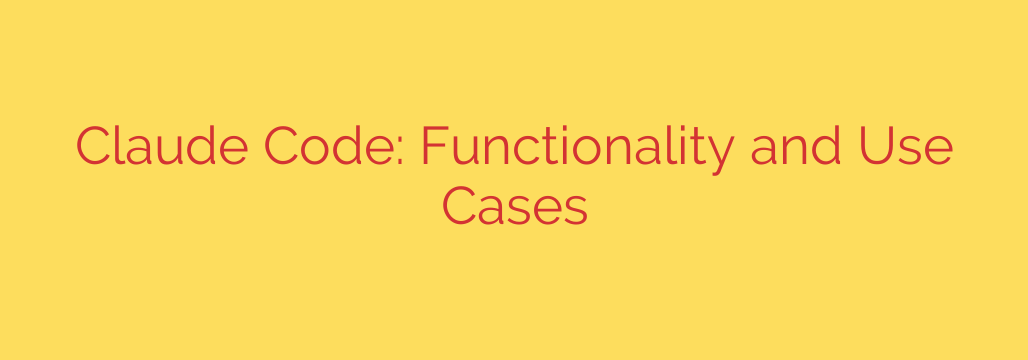
Claude Code Explained: Your New AI Partner in Software Development
In the ever-evolving landscape of software development, efficiency and accuracy are paramount. Developers are constantly seeking tools that can streamline workflows, reduce tedious tasks, and enhance code quality. Enter the new generation of AI-powered coding assistants, designed to act as a collaborative partner in the development process. One of the most powerful and intuitive of these is Claude Code.
This guide explores what Claude Code is, its core functionalities, and how you can leverage it to become a more productive and effective programmer.
What is an AI Coding Assistant?
At its core, an AI coding assistant is a sophisticated tool trained on vast amounts of code, documentation, and programming knowledge. It uses this knowledge to understand natural language prompts and assist with a wide range of coding tasks. Unlike a simple autocomplete function, these assistants can grasp context, understand complex logic, and engage in a conversational way to help solve programming challenges.
Think of it as a pair programmer that is available 24/7, has encyclopedic knowledge of multiple languages, and never gets tired of answering questions.
Core Capabilities: What Can You Actually Do With It?
The true power of an AI coding assistant lies in its versatile skill set. It goes far beyond simple code generation to offer support across the entire development lifecycle.
Intelligent Code Generation: This is the most well-known feature. You can describe a function or logic in plain English, and the AI will generate the corresponding code in your specified language. For example, you could ask it to “write a Python function that takes a list of URLs and checks for a 200 status code asynchronously.” It generates entire code blocks, classes, or even simple scripts based on your requirements, dramatically speeding up initial development.
Advanced Debugging and Error Analysis: We’ve all spent hours hunting for a single elusive bug. With an AI assistant, you can paste a problematic code snippet and ask, “Why am I getting a NullPointerException here?” The model will analyze the code, identify the likely cause of the error, and often suggest a specific fix. This transforms debugging from a frustrating search into a guided problem-solving session.
Code Explanation and Learning: Confronted with a complex algorithm or an unfamiliar library? An AI assistant can act as a personal tutor. You can provide a piece of code and ask for a line-by-line explanation. This is invaluable for learning new programming languages, onboarding new team members, or simply getting up to speed on a legacy codebase.
Language Translation and Modernization: Need to convert an old script from Python 2 to Python 3? Or perhaps you need to translate a function from Java to C#? AI assistants excel at this. They can convert code between languages while preserving the core logic. This capability is also crucial for modernizing legacy systems, such as converting outdated COBOL code into a more modern language like Java.
Automated Test Generation: Writing unit tests is critical but can be repetitive. You can provide a function and ask the AI to generate a comprehensive set of test cases, including edge cases you might not have considered. This helps improve code coverage and ensures your application is robust and reliable.
Practical Use Cases for Developers and Teams
Integrating an AI coding assistant into your workflow can unlock significant benefits for individual developers and entire teams.
Accelerating Prototyping: When building a Minimum Viable Product (MVP) or a proof-of-concept, speed is everything. An AI assistant can help you rapidly scaffold an application, generate boilerplate code, and implement core features, allowing you to move from idea to execution in record time.
Enhancing Code Quality and Reviews: Use the AI as a “first pass” for code reviews. Before submitting your code, you can ask it to check for potential bugs, suggest performance improvements, or ensure adherence to best practices. This helps catch issues early and allows human reviewers to focus on higher-level architectural decisions.
Breaking Through Creative Blocks: When you’re stuck on a complex problem, describing it to the AI can help clarify your own thinking. The model can offer different approaches, suggest alternative algorithms, or provide a starting point that helps you break through the mental block and move forward.
Improving Documentation: Good documentation is often an afterthought. An AI assistant can automatically generate docstrings, comments, and even high-level README files based on your code, making your projects easier for others (and your future self) to understand.
Actionable Security Tips for Using AI Assistants
While incredibly powerful, it’s essential to use these tools responsibly. Your code and intellectual property are valuable assets.
Be Specific and Provide Context: The more context you provide, the better the output. Instead of “write a sort function,” try “write a stable merge sort function in Go for a slice of structs, sorting by the ‘Timestamp’ field.”
Review and Verify All Generated Code: Treat the AI’s output as a suggestion from a very knowledgeable but fallible junior developer. Always review, test, and understand the code before implementing it. Never blindly trust AI-generated code, especially for critical production systems.
Prioritize Security: Never Input Sensitive Data: This is the most important rule. Do not paste proprietary code, API keys, passwords, personal data, or any other sensitive information into a public or third-party AI tool. Always assume your inputs could be used for training or may be seen by others. Use it for general logic, algorithms, and public-facing code snippets only.
By integrating an AI coding assistant thoughtfully and securely, you can augment your skills, eliminate programming friction, and focus on what truly matters: building great software.
Source: https://collabnix.com/what-is-claude-code-and-what-problem-does-it-solve/








